
Related
Guests
- Andrew Revkinaward-winning science reporter with The New York Times. His latest book is titled The North Pole was Here: Puzzles and Perils at the Top of the World.
The U.N. Intergovernmental Panel on Climate Change is set to release a report this Friday that is expected to underline that while global warming is changing physical and biological systems on every continent, Western countries must take extra steps to address the growing “climate divide.” We speak with New York Times environmental reporter, Andrew Revkin. [includes rush transcript]
Transcript
AMY GOODMAN: The Supreme Court has ruled the Environmental Protection Agency has the authority to regulate the emission of greenhouse gases linked to global warming. In a 5-4 decision, the court ruled the EPA violated the Clean Air Act by improperly declining to regulate new-vehicle emissions standards to control the pollutants that scientists say contribute to global warming. It’s the first high court decision in a case involving global warming and is seen as a defeat for the Bush administration, which has refused to view carbon dioxide as an air pollutant subject to EPA regulation.
The ruling comes as a new report from the world’s leading group of climate change experts is set for release this Friday. The U.N. Intergovernmental Panel on Climate Change is expected to underline that while global warming is changing physical and biological systems on every continent, Western countries must take extra steps to address the growing “climate divide.” Poor countries have bore the brunt of environmental problems from the release of carbon dioxide by the U.S. and western Europe, but have been left almost entirely on their own to deal with the consequences. This means that while Western countries spend billions on dealing with the effects of climate change, those most in need receive little funding to deal with far greater catastrophe.
On Monday, panel chair Rajendra Pachauri called on Western countries to address the disparity.
RAJENDRA PACHAURI: What we are really talking about is as much an ethical issue as an issue that sort of concerns the stability of global society. In the Framework Convention on Climate Change, it’s clearly specified that resources will be provided by the developed countries to the developing world and that transfer of technology, in particular, will be facilitated by the developed countries. So I think it’s there in the agreement, but it’s a question of implementing it both in letter and spirit, and there, may I say, enough is not happening.
AMY GOODMAN: Rajendra Pachauri, who chairs the Intergovernmental Panel on Climate Change. European Environment Commissioner Stavros Dimas also talked about the U.S. role as the world’s leading emitter of greenhouse gases.
STAVROS DIMAS: It’s obvious that the importance of the United States is paramount, because they are emitting about one-fourth of the world’s emissions of greenhouse gases, and also they have a very high per capita income, and they have contributed historically to the creation of the greenhouse phenomenon more than any other region in the world, with the exception of the European Union countries. So they have a duty to come along in an international agreement after 2012.
AMY GOODMAN: For more on the latest, I am joined now by Andrew Revkin. He’s an award-winning science reporter for The New York Times, author of several books. His latest is called The North Pole was Here: Puzzles and Perils at the Top of the World. In today’s New York Times, Andrew Revkin writes, “A growing array of officials in developing countries and experts on climate, environmental law and diplomacy insist that the first world owes the third world a climate debt.” Andrew joins us from a studio in Watertown, Massachusetts. Welcome to Democracy Now!, Andrew.
ANDREW REVKIN: It’s good to be here.
AMY GOODMAN: Before we talk about the global climate divide between rich and poor countries, let’s go to this U.S. Supreme Court decision that has rocked the Bush administration. Can you talk about its significance?
ANDREW REVKIN: Well, there was only one time that George Bush, as far as I know, ever described carbon dioxide, the main greenhouse gas, as a pollutant. That was when he was running for president. He pledged to limit emissions of this gas, along with other stuff, from power plants, but then, right after he got elected, he back-pedaled away from that campaign pledge. And then, from that point onward for the administration, the idea that carbon dioxide might be a pollutant like lead or sulfur dioxide, the stuff that we’re more familiar with as harmful substances, kind of went away. They just — it was a bright line in the sand, and anything that looked like it would move in that direction they fought really, really hard.
And now, the Supreme Court has kind of just sort of taken away that whole presumption that there’s some reason not to look at carbon dioxide as a hazard when it’s in excess amounts, which is this whole question — how much carbon dioxide is too much? — has gone away. The Supreme Court essentially said the EPA can’t just sort of say we’re not going to examine that question, particularly in this case because the EPA contended two things. They said the science isn’t there that there’s risk. And they also said that they can make a choice based on policy considerations. The Supreme Court justices have basically said there is a clear case for risk and that the EPA is required, essentially, to take a fresh look.
AMY GOODMAN: Can you talk about who voted which way, the 5-4 decision, the significance of Roberts joining with Alito and Thomas and Scalia in voting against — or for the Bush administration?
ANDREW REVKIN: The significance essentially is that there is still a big chunk of — there are people who are aligned with industry. There are people who just purely don’t believe that a gas like carbon dioxide, the bubbles in beer, can actually be in the same basket with things like sulfur dioxide or mercury. And I’m not sure there’s a pure ideological divide on the court on this. I do think that the science is not easy. And even during arguments, Scalia said — there was at one point — it was an amazing moment during the arguments over this — Scalia — there was some confusion about the troposphere versus the stratosphere, and Scalia said something like, “Troposphere, stratosphere, that’s why I don’t want to have to deal with this global warming problem. It’s complicated.”
And I do feel that in this country there is still a big block of people — I got huge amounts of email when these stories have run in the last couple of days of mine on adapting to warming from people who just don’t even get the basics, that carbon dioxide makes the world warmer than it would otherwise be. If you have more of it in the atmosphere, that makes the world warmer.
On that point — and the Supreme Court obviously now has echoed this — there is simply no knowledgeable disagreement in the scientific community. Even Michael Crichton, at a recent debate in New York City, the author of State of Fear, you know, which says that all environmentalists are fearmongers, he and Richard Lindzen, a scientist at MIT who has attacked alarmist portrayals of the climate problem, they both agree that carbon dioxide is a greenhouse gas. You put more of it in the air, it warms the world. And then it all comes down to judgments about how dangerous that is and what you do about it.
AMY GOODMAN: We’re talking to Andrew Revkin, award-winning science reporter with The New York Times. Now, explain, though, exactly what this means, for example, for California?
ANDREW REVKIN: Well, California is trying to restrict vehicle emissions of carbon dioxide, and they claim they have the authority to do so. And this case actually relates to that one, in that now California will probably have an easier time moving ahead on that on its own efforts to do that locally.
One thing that was really telling, I thought, in reading the USA Today this morning, their story on this case, the Alliance of Automobile Manufacturers, the main lobbying group in Washington for the auto companies, which had been stridently, you know, fighting the idea that CO2 was a regulatable gas, now they’ve immediately switched to “We need an economy-wide standard for limiting it.” They’re basically — you see this — or I’ve seen this in 20 years of writing about climate change, this kind of stepwise defense. It’s just like an army defending in a retreat. You kind of hold your ground, hold your ground, then move back to the next safe defense. And you can see that dynamic playing out here.
AMY GOODMAN: What about the role of the auto industry in all of this and the whole issue of how federal scientists’ research has been suppressed, as we saw recently in a congressional hearing?
ANDREW REVKIN: Well, for years, I’ve been exposing, in a series of stories in the Times, specific instances where people who had worked for the oil companies or people who were political appointees who had worked in the Bush re-election campaign were expressly trying to restrain scientists who felt that global warming was a problem and that carbon dioxide is a hazard from speaking their views. And this came to the fore just a few weeks ago in a couple of congressional hearings. And there, too, you see this — there has been some change. NASA, one of the agencies were that had happened, has changed their policies. NOAA came out with some new policies that scientists still aren’t very happy with. That’s the agency that studies the climate directly. But scientists that I talk to now feel much freer to speak their minds and not necessarily have a minder on the telephone anymore, as was the norm at NOAA for a long time. I do get a sense of the ball rolling here in a way that in twenty years on covering this issue I haven’t seen.
AMY GOODMAN: Andrew Revkin, we have to break for a minute. We’re going to come back to this discussion. And then we’ll be talking about what’s happening in Somalia, in Iraq, and in Africa as a whole. We’ll be speaking with a former U.N. spokesperson in Iraq, Salim Lone, who now lives in Kenya. This is Democracy Now!, democracynow.org. We’ll be back with the New York Times science reporter in a minute.
[break]
AMY GOODMAN: “Empire State Blues” by Uncle Wade, a band — well, our guest is a member of, Andrew Revkin, the award-winning science reporter at The New York Times. This is Democracy Now!, democracynow.org, The War and Peace Report. I’m Amy Goodman. Andrew, you’ve been doing in the last few days a series of pieces on the global divide between rich and poor nations. Can you talk about what you found?
ANDREW REVKIN: Basically, there’s several kinds of divides. Most of the wealthy nations of the world built a lot of their wealth on the industrialization that took place largely on the backs of fossil fuels, coal and oil. And what happened is the carbon dioxide, the main greenhouse gas released by burning those fuels, accumulates in the air. It builds up and builds. It doesn’t just go away when you turn off the engine. So there’s a historical contribution from countries like the United States and the countries of Europe and the former Soviet Union that is the vast majority of the gas. There’s been a lot of discussion recently about China. You know, its economy is in super-high gear now, and any day now it’s probably going to surpass the U.S. in annual emissions, but China is a very small fraction of that accumulated human influence on the climate.
So what we did was we looked around at countries that are prosperous and at countries that are not. The pieces that are in today at nytimes.com/earth, we went to four different countries — two poor and two rich — and found that the rich are all very happily adapting to climate extremes right now. We do things that money affords. Down in Perth, Australia, they’ve just built a huge plant that turns saltwater into drinking water, and it’s powered by a wind farm. And if that isn’t a sign of the potential for a wealthy country to essentially deal with the hard knocks of climate change, by just turning wind into water, essentially, I don’t know what does.
And then two reporters went to Malawi, one of the poorest countries on the planet, and to a part of India that’s chronically flooded by heavy downpours. And there, we could see that the lack of resources gives you this huge constant vulnerability even now to the impacts that come with heavy climate extremes: big storms, rising seas and drought. And essentially — so the countries that have created or are propelling us toward a warmer world with more extremes of these kinds are already insulating themselves. Even though they, under a treaty back in 1992, signed by the first President Bush, the rich countries of the world committed to helping the poor countries adapt to climate change, it just isn’t happening.
AMY GOODMAN: In a place like Malawi, what actually takes place?
ANDREW REVKIN: Well, agriculture is mostly fed by rain. That’s true, you know, in the Corn Belt of the United States, too. But it’s very flukey. You have a year of floods and then a year of drought, and on and on. There’s very little ability to store water. Groundwater there, in the place where our correspondent Sharon LaFraniere went, was contaminated by the recent flood. So it’s kind of always a scrabble, and these rural farmers can barely get by as it is. So when you push things a little farther — and, by the way, all the climate models, one of the places they’re most confident on there being some pretty harsh changes is southern Africa. That whole sub-Sahelian part of Africa down to the very tip is going to dry, particularly in the sort of June, July, August, and that is an area that really can’t afford that right now.
There’s even some discussions by some scientists that we quoted that, you know, in countries like that, essentially, the idea that they’ll ever be self-sufficient in agriculture has to kind of go away. They have to — what has to happen there is some efforts to assist them in urban development — get people off the land — so that they have the income from other kinds of enterprises that can allow them to purchase food from wetter places. The other element in this climate divide is that moisture, precipitation is moving toward the poles, away from the Equator. You look at a map of economics, you know that all the rich countries in the world are more mid-latitude and up, and all the poorest countries of the world, Australia being kind of closer to the Equator than most, are generally in different places.
AMY GOODMAN: Andrew Revkin, you write China may be a powerhouse now, but it’s contributed less than 8 percent of the total emissions of carbon dioxide from energy use since 1850, while the U.S. is responsible for 29 percent; western Europe, 27 percent.
ANDREW REVKIN: Yeah, that’s it. You know, again, it’s this cumulative — it comes down to an ethical question of what are we are obligated to do to assist countries that will be most impacted by the changes that are forecast in a warming world, based on our historic contribution to that setup. Obviously, we didn’t know for 150 years that these gases released by burning coal and oil were going to do this. We have known that, with increasing confidence, for at least a couple of decades — three decades, really.
And now, the picture is pretty crystal clear that, again, especially in the long run — the reason I wrote The North Pole was Here, my new climate book for the next generation, is this is a long-haul enterprise here. In the long picture, we’re talking about places on earth that will be really profoundly transformed. Coasts will be, you know, retreating. In the Arctic, which we spent a lot of time reporting on a couple years ago, there will be profound change. And in some of the drier places in the world, they’ll be getting drier.
There will be benefits, for sure. There will be places that are going to get wetter, including the upper tier in North America, where — and also growing seasons will be getting longer, which obviously will benefit farmers, at least for decades. And so, that’s another part of this inequity. It gets to be very interesting. When you look at the planet now, look at who created the historical — this problem that exists now, regardless of future trajectories for emissions, like in China, you get a pretty complicated picture.
AMY GOODMAN: Andrew Revkin, I was listening to Joe Barton, former head of the House Energy Committee, still a powerhouse on that issue, talking about how global warming is good for us. For example, it will mean longer growing seasons in places like Russia. I wanted to ask about the critics, like Barton and Inhofe — I know Inhofe attacked your book The North Pole was Here on the floor of Congress, saying, “The author of the book, New York Times reporter Andrew Revkin, wrote that it may someday be easier to sail than to stand in the North Pole in summer. So here we have a very prominent environmental reporter for The New York Times who is promoting aspects of global warming alarmism in a book aimed at children.”
ANDREW REVKIN: Pretty wild stuff. Frankly, all of the modeling shows late in this century the prospect of an open-water Arctic Ocean in summertime, and that literally means — having stood at the North Pole on ice that’s cracking and shifting and always kind of tentative, it will clearly be easier to sail than to stand on the North Pole later in this century. And I did have that word “may,” which — you know, this was a book that was just lauded by the National Science Teachers Association and Children’s Book Council as one of the best science books of 2006, and I’ll take their view over the senator’s view any time.
AMY GOODMAN: Well, you have that senator, but then you have the former senator and former presidential candidate Al Gore and his film. Can you talk about the effect of An Inconvenient Truth on the political debate in this country?
ANDREW REVKIN: Sure. I’ve written about the film a few times and about this effort by Al Gore and others to really, you know, get under people’s skin and propel them and, to some extent, scare them into action. Frankly, in some stories that I’ve done, I talk to a lot of people who question that tactic as being the thing that will do the magic trick of making our country change its habits related to fossil fuels and look with a longer term at how we weigh risks.
There’s some danger in trying to portray this huge slowly developing planetary-scale problem as a planetary emergency, that people will tune out if nature, in all of its wonderful variability, sort of throws a few cold years at us, which is entirely possible. In fact, it’s impossible for that not to happen. Nature doesn’t work in smooth ways. And there’s still a lot of things about global warming that we don’t know clearly. We do know the basics. As I said earlier, you know, even Michael Crichton and Richard Lindzen of MIT agree on the basic idea that more greenhouse gases make the world warmer. But when you get into things that were very featured in the film, like hurricane intensity or how quickly the Arctic will go ice-free, those are more complicated scientific questions, and they’re not a slam dunk.
And so, I, in The North Pole was Here and in my writing, I’ve tried to emphasize the middle, meaning in the science that no one disagrees on presents a pretty powerful picture already of a world in transition from being a place that was not influenced by people on a global scale to one in which we now have our hand on the thermostat of a planet. And it’s a one-way thermostat, because of that long-lived nature of these greenhouse gases. So you can’t kind of suddenly say, “Oh, geez, we turned the heat up too high. We have to turn it down.” It won’t work that way. And so, that — there is a legitimate question, I think, that many experts have raised about this idea of trying to portray this as an old-style catastrophe in the making, because it is more nuanced than that.
AMY GOODMAN: Andrew Revkin, by the way, was the first New York Times reporter ever to file stories and photographs from the floating sea ice at the top of the world. Andrew, I wanted to ask about the tsunami and the Solomon Islands. Is that related at all to global warming?
ANDREW REVKIN: Not to global warming at all, although it is related to — again, the harsh reality is poor people are more vulnerable to extremes, coastal or climatic, than rich people. New Orleans showed that we have our own vulnerabilities, as well. But as — you know, in writing a lot about that disaster — we certainly can’t blame a lack of knowledge. We can blame a lack of investment in levees and things that, again — but at least we have the capacity to build levees when we need them. In places like the Solomon Islands or in a lot of those coastlines along the Indian Ocean, where they were swept in the terrible tsunami in 2004, that I spent a lot of time writing about, too, there’s no infrastructure.
As we wrote in today’s piece on climate adaptation, in one of the — in India, where Somini Sengupta went for us for today’s story, their idea of an alarm system for a flash flood is an official running around with a megaphone. And that’s essentially the same. We already have these buoys now in the world’s oceans to alert us when a tsunami is coming to the East Coast or parts of Asia, but how do you get that information to a Solomon Islander? You don’t. So there is an imbalance in our vulnerability to what nature can throw at humans. And that’s going to be there for a long time, until economic prosperity lifts developing countries more into being more developed.
AMY GOODMAN: I wanted to end with New Orleans. You say we have the capacity to build levees. But have the levees been built?
ANDREW REVKIN: No, no. New Orleans is still an underprotected city. It’s a city — you know, when you have a city that’s below sea level and in a zone where we know Category Five hurricanes prowl, whether or not climate change will intensify storms, you have a profound kind of a — you’re rolling the dice every year. And New Orleans, the investments in the levees there were always under-invested on the side that required local money. The Mississippi side of New Orleans, Mississippi River side, was girded like to a gold standard, because it was part of this big 17-state defensive for flooding. But they left the backdoor open, and that’s where Katrina hit.
The problem in a city like New Orleans really is that, as one sociologist and historian told me for a story I did, it’s a city that’s impossible and inevitable, that nature makes it almost impossible, but its circumstances, its geography, makes it almost inevitable. And when we have a situation like that, given the wealth in this country and the scientific expertise, for it to remain vulnerable — either people have to move out of areas that really can’t be protected affordably, or a lot more has to be spent on girding a place like that, that has those characteristics.
AMY GOODMAN: Andrew Revkin, I want to thank you for being with us, award-winning science reporter for The New York Times. His latest book is The North Pole was Here: Puzzles and Perils at the Top of the World. His earlier book, The Burning Season: The Murder of Chico Mendes and the Fight for the Amazon Rain Forest.

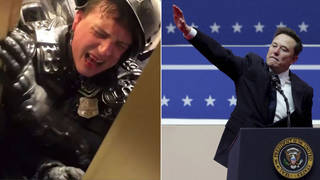
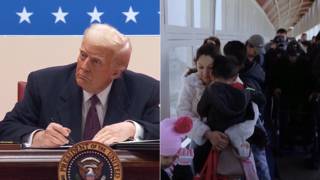
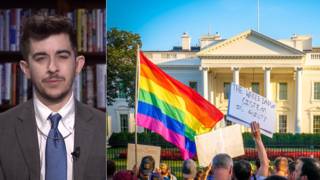
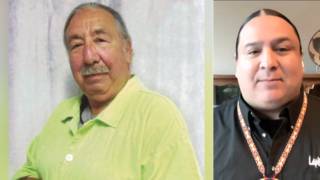
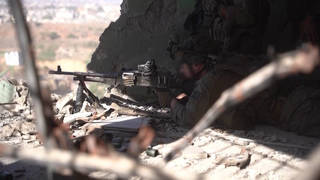




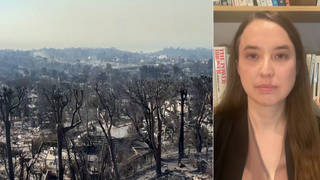
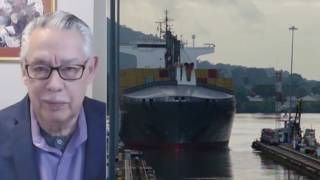

Media Options